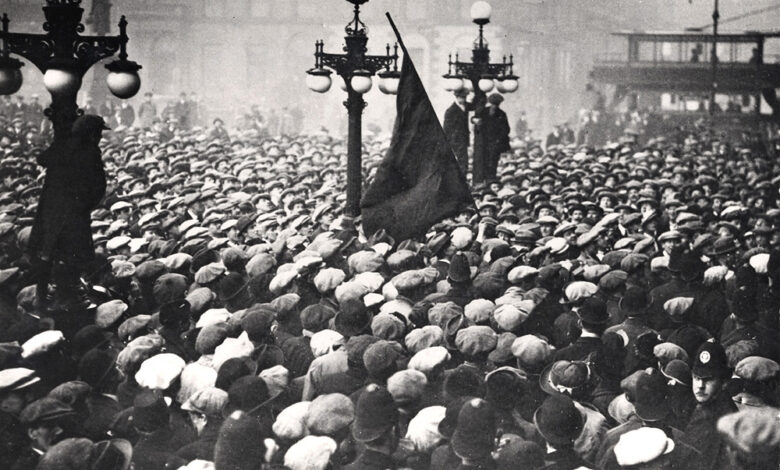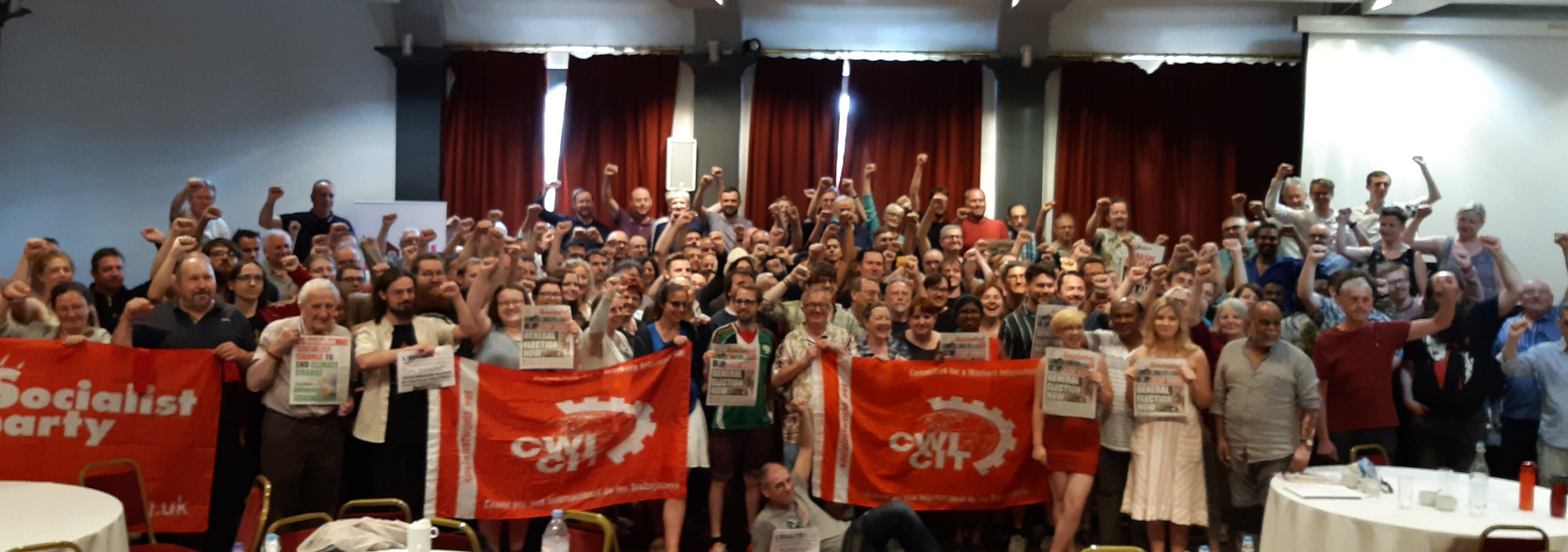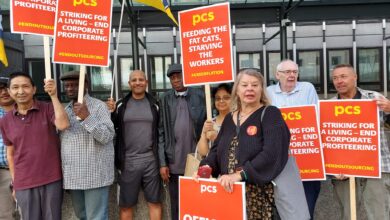Red Clydeside: Workers’ power on display

Brian McLelland
Red Clydeside refers to a significant era of the labour movement in early 20th-century Scotland, centred around Glasgow and the River Clyde industrial area. This period holds great importance for socialists today, offering inspiration and valuable lessons for ongoing industrial struggles.
The key lesson of Red Clydeside is the critical potential power of the working class to challenge and overthrow capitalism. Several notable events unfolded during this era, including rent strikes in 1915, huge anti-war demonstrations, a massive engineering workers’ strike in January 1919, and the Battle of George Square later that month.
Red Clydeside emerged with the 1911 strike at the Singer factory in Clydebank – the world’s largest sewing machine factory at the time. The unfair dismissal of three women workers resulted in a strike by 12 women workers on the morning of 21 March 1911.
The strike quickly gained solidarity, with over 10,000 workers striking by noon, even without trade union involvement. However, due to a lack of leadership and collective organisation, the strike failed to achieve a victory, and 400 leading activists were dismissed. Despite the defeat, the strike showcased the spirit of class solidarity and foreshadowed future struggles.
From 1910 to 1914, Clydeside experienced a surge of industrial action. Working days lost to strike activity in this period were four times the level recorded for 1900-10. Previously acquiescent groups of workers became increasingly radicalised, with women and unskilled workers playing significant roles.
Trade union membership rose sharply, with the number affiliated to the Scottish Trades Union Congress (STUC) rising from 129,000 in 1909 to 230,000 in 1914.
Housing
While British capitalism was leading the way internationally with its mighty productive forces generating colossal profits for the owners of the shipyards, steelworks and coal mines, the working class was forced deeper into poverty. Glasgow was known as ‘the engine room of Britain’ for its concentration of heavy industry. However, those workers tending the ‘engine room’ were living in terrible conditions as the city failed to accommodate its hugely increasing workforce, with overcrowding and poor sanitation rife. The population expanded from 200,000 in 1851 to around one million in 1911.
As war broke out in 1914, thousands of working-class men left their homes to join the armed forces, being led to the slaughter in the name of protecting the profits and stature of the British Empire. The war machine required vast production in the arms industry, which led many thousands of other men and their families to move to the city to provide the required workforce.
Meanwhile Glasgow’s housing stock was stagnating. The developing housing crisis worsened, with landlords seizing the opportunity to increase rents. Many families, especially those with absent main wage earners serving in the war, could not afford the higher rents. The housing stock was increasingly overcrowded and dilapidated – in the years 1912-15 alone, the population of Glasgow increased by 65,000 while only 1,500 new housing units were constructed.
Soon after the rent increases, eviction orders were being put in place as well as intimidation tactics by landlords. In response, local people in Glasgow organised a widespread campaign against evictions and rent increases. The Glasgow Women’s Housing Association, led by figures like Mary Barbour, spearheaded the rent strike movement courageously. The first rent strike took place in Govan, with tenants staging mass demonstrations against evictions. Similar protests erupted in various areas around the city, culminating in large-scale demonstrations of up to 25,000 people in the city centre.
While the organised labour movement supported the rent strikes, direct involvement only came when attempts were made to break the strikes by targeting strikers’ wages through arrestment orders. 18 strikers were summoned by the Small Debt Court.
Thousands of shipyard workers showed solidarity by downing tools and marching alongside ‘Mrs. Barbour’s Army’ to the court where the case was being heard. The pressure exerted on the authorities resulted in the abandonment of the court proceedings and the implementation of a Rent Restrictions Act, securing a victory for the working class. And although the act itself was only meant to be in place until six months after the end of the war, certain sections of it were not actually repealed until Thatcher’s third term in office!
John Maclean
Red Clydeside witnessed influential anti-war activism driven by the working class. The Clyde Workers Committee (CWC) emerged as a key force, uniting Clydeside workers against repressive legislation like the Defence of the Realm Act 1914 and the Munitions of War Act 1915.
Led by trade unionist Willie Gallacher, the CWC represented workers in shipyards and engineering works in Glasgow. Revolutionary socialist John Maclean and his political allies aided the CWC, countered media attacks on striking workers, exposing government and employer hypocrisy in prioritising profits over workers’ lives through weekly and sometimes daily bulletins. Maclean was always calling for the industrial struggle to be backed with a proper political struggle for socialism, including building a revolutionary party to carry out that strategy.
However, as he was not directly involved in the trade unions and workers’ committees (although he was often invited to participate in workers’ meetings and taught Marxist economics to hundreds of shop stewards from the factories and yards) his influence could only go so far. Gallacher, on the other hand, followed a more syndicalist approach, believing industrial action alone could achieve socialism, which proved problematic later.
The Women’s Peace Crusade, spearheaded by Helen Crawfurd, Mary Barbour, Agnes Dollan, and Mrs Ferguson, emerged as another significant anti-war vehicle. It focused on grassroots, working-class activism, diverging from the middle-class-oriented Women’s International League. They organised open-air meetings and demonstrations in working-class communities, culminating in a major march to George Square on 17 December, 1917, where they broke through police cordons to occupy the City Chambers.
Significant events in Russia in 1917, starting with the overthrow of the Tsar in February and particularly the working class taking power in October led by the Bolsheviks, rejuvenated the revolutionary spirit of Red Clydeside. A massive May Day demonstration of around 80,000 people championed the defence of the Russian Revolution, socialism in Britain, and the release of John Maclean, who had been imprisoned in early 1916 for his anti-war propaganda. The ruling class feared Maclean’s influential Marxist teachings that inspired Glasgow’s working class. Eventually the determined campaign to free Maclean was granted its aim – the demonstrators all marched to Duke Street prison to celebrate their victory.
Maclean and other workers’ leaders on Clydeside ardently supported the Bolsheviks and vocally advocated for their cause. Maclean’s appointment as Russian Consul in early 1918 further intensified support, and a massive march and demonstration followed.
However, Maclean was arrested again in April 1918, and sentenced to five years in prison for sedition. Maclean made his own defence in the court and gave a famous speech from the dock, which included the immortal words: “No human being on the face of the earth, no government is going to take from me my right to speak, my right to protest against wrong, my right to do everything that is for the benefit of mankind. I am not here, then, as the accused; I am here as the accuser of capitalism dripping with blood from head to foot.”
The Glasgow May Day demonstration in 1918 shared similar goals as the previous year but now took place on a working day, bringing many workers out on strike. They expressed support for the Bolshevik government, demanded an immediate end to the war, and called for Maclean’s release with increased fervour.
Later in 1918, the workers achieved the aims they had been campaigning for so courageously, with the armistice signed on 11 November, and Maclean released from Peterhead Prison seven months into his five-year sentence. He returned to Glasgow on 3 December to a tumultuous welcome. The genuine prospect of a workers’ revolution in Germany, the growing strength of the labour movement in Glasgow and across Britain, and the possibility of revolution across Europe was a major factor that ended the war.
The fact that the anti-war campaign survived at all in the atmosphere of substantial government anti-German, pro-war propaganda and an obnoxious jingoistic pro-war press is a testament to the principled radicalism and outstanding courage of John Maclean and his comrades, the workers, women, and youth involved throughout Red Clydeside and across the isles.
The war’s end brought disillusionment as returning soldiers were promised a “land fit for heroes” but the reality was far from it! The fear of mass unemployment loomed as demobilisation reduced orders in industries like shipbuilding, railways, and munitions.
The labour movement rallied behind the CWC campaign for a shorter working week to address the impending crisis, advocating a 30-hour week. However, the leadership of the Amalgamated Society of Engineers (ASE) ignored the workers’ position and negotiated for a 47-hour week with employers. This led the CWC to organise a shop stewards’ conference demanding a stronger campaign for a 30-hour week, which resulted in a compromise of a 40-hour week demand. The conference also agreed to call for a general strike on 27 January 1919.
The response to the general strike call was overwhelming, with 40,000 workers from Clydeside factories and engineering works out by 29 January. Miners from nearby regions joined in with solidarity strikes, and discharged servicemen served as flying pickets, expanding the action. The ASE and miners’ union leadership opposed the strike but couldn’t assert much influence. Striking miners occupied their union headquarters, demanding support for a general strike.
George Square
On the Wednesday, another rally took place in George Square wherein the Lord Provost met with the strikers’ delegates. They were promised representation to the government and asked to return on Friday for a response. However, this turned out to be a critical mistake, the ruling class began actively drawing up plans to break the strike as they feared it spreading across Britain. 100,000 workers in Belfast were already striking for a 44-hour week.
On Friday 31 January, tens of thousands of workers assembled in George Square to hear the negotiation outcome. Police surrounded the square, and at 12.20pm, they launched a fierce baton charge, attacking and arresting CWC leaders Davie Kirkwood, Manny Shinwell, and Willie Gallacher. Accounts vary on the police charge with some saying it was unprovoked, others that it was from workers raising the red flag above the crowd, others that it was from strikers forcibly stopping trams running through the adjacent streets. At any rate, the police were fully intent on intervening to break the strike.
Despite the attack, the demonstrators stood their ground, engaging in battles with the police and eventually driving them back. They regrouped and marched, with ex-servicemen leading, to Glasgow Green where the police awaited. Again, the strikers fought back, forcing the police to retreat.
The government had ordered troops into the city to restore order among what the Secretary of State for Scotland, David Munro, had named “a Bolshevist uprising”. Young, mostly untried, troops were specifically deployed from other areas of Scotland and northern England, despite there being a military barracks in Maryhill (within the city area) – this was because they were all veterans of the front and could not be trusted to obey orders and set their sights on the strikers. 10,000 troops and six tanks were deployed to Glasgow.
Ultimately the revolutionary potential of Red Clydeside was not fully realised. The strike was led by industrial organisers who focused on their immediate industrial goals rather than a broader political struggle. Willie Gallacher would later acknowledge that there should have been a march to the Maryhill barracks to enlist the support of the troops stationed within, easily persuading the soldiers to come out in support of their fellow Glaswegians. “We were carrying on a strike when we ought to have been making revolution.”
The lack of a political organisation armed with a socialist programme to direct all the pressure of the working class into a weapon with which the capitalist state can be overthrown was ultimately a decisive factor for the Red Clydeside movement. Only through this means, convincing the working class to be conscious of the power they wield through a politically armed industrial struggle, of the need to finally break with capitalism, would the working class have come to power – as in the Russian Revolution of October 1917. If a Bolshevik-style revolution had truly occurred in Glasgow in 1919, it could have spread like wildfire across Britain, particularly the industrial areas, and beyond.
Instead, the outcome of the Battle of George Square, was that the bosses retained their power and the strike ended within a week. Although the working class secured a reduction in the working week to 47 hours, the movement faced increasing challenges as the revolutionary wave post-1917 ebbed for a period.
Repressive measures and anti-working class legislation from the ruling class, coupled with its influence on the bureaucratic trade union leadership, also contributed to the movement’s decline. Although a couple of years later it erupted at an even higher level during the 1926 general strike in Britain.
The poor health of Maclean, owing to his endless programme of political activity and his spells in prison being force-fed and undertaking hard labour, led him to meet an unfortunate early demise on 30 November, 1923, aged 44. Scotland had lost its greatest ever socialist.
Thousands of workers and their families around Glasgow attended his funeral, his name never to be forgotten and his ideas never to perish. We must continue to organise against such measures and unite in struggle across the board to fight for the socialist transformation of society, taking inspiration from the legacy of Red Clydeside.
The industrial base on the Clyde has diminished since those days but the basic chorus of united struggle against the bosses for a fairer, socialist society must be remembered and brought to life once again, to reverberate throughout the various public and private sector disputes we encounter today.



